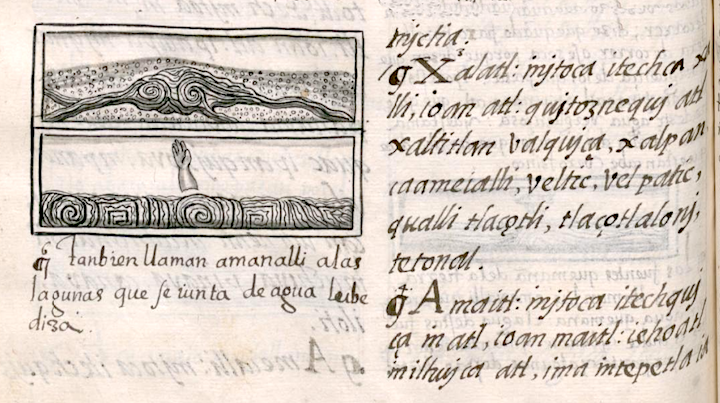amaitl (FCbk11f225v)
This is a compound glyph for amaitl, the name of a certain kind of body of water, such as a narrow inlet or bay. The entry concerned with it appears on folio 225 verso of Book 11, “Earthly Things,” Chapter 12, of the General History of the Things of New Spain, also known as the Florentine Codex. This compound features a swirling body of water (atl) and, above it, a human hand and arm (maitl). Both are outlined in black with a little shading. The hand is represented vertically, while the water is horizontal, with classic rounded and squared off swirls in a series. Other lines in the water suggest its watery, moving nature.
Robert Haskett
Amaitl seems to refer to a kind of fjord or a fairly narrow inlet or bay. Anderson and Dibble translate the Nahuatl description found in the codex as, “an arm of the sea which is extending among the mountains, which is becoming narrow as it extends” (Book 11, Natural Things, Chapter 12, 250).
Robert Haskett
Amaitl
amaitl
Robert Haskett
1577
Robert Haskett
inlets, fjords, water, agua, fiordos, bahías, ensenadas

a(tl), water, body of water, etc., https://nahuatl.wired-humanities.org/content/atl
mai(tl), hand or arm, https://nahuatl.wired-humanities.org/content/maitl
la ensenada
Stephanie Wood
Library of Congress, https://www.loc.gov/item/2021667856/.
The Library of Congress is unaware of any copyright or other restrictions in the World Digital Library Collection. Absent any such restrictions, these materials are free to use and reuse. Researchers are encouraged to review the source information attached to each item. If you do publish anything from this database, please cite the Visual Lexicon of Aztec Hieroglyphs.



